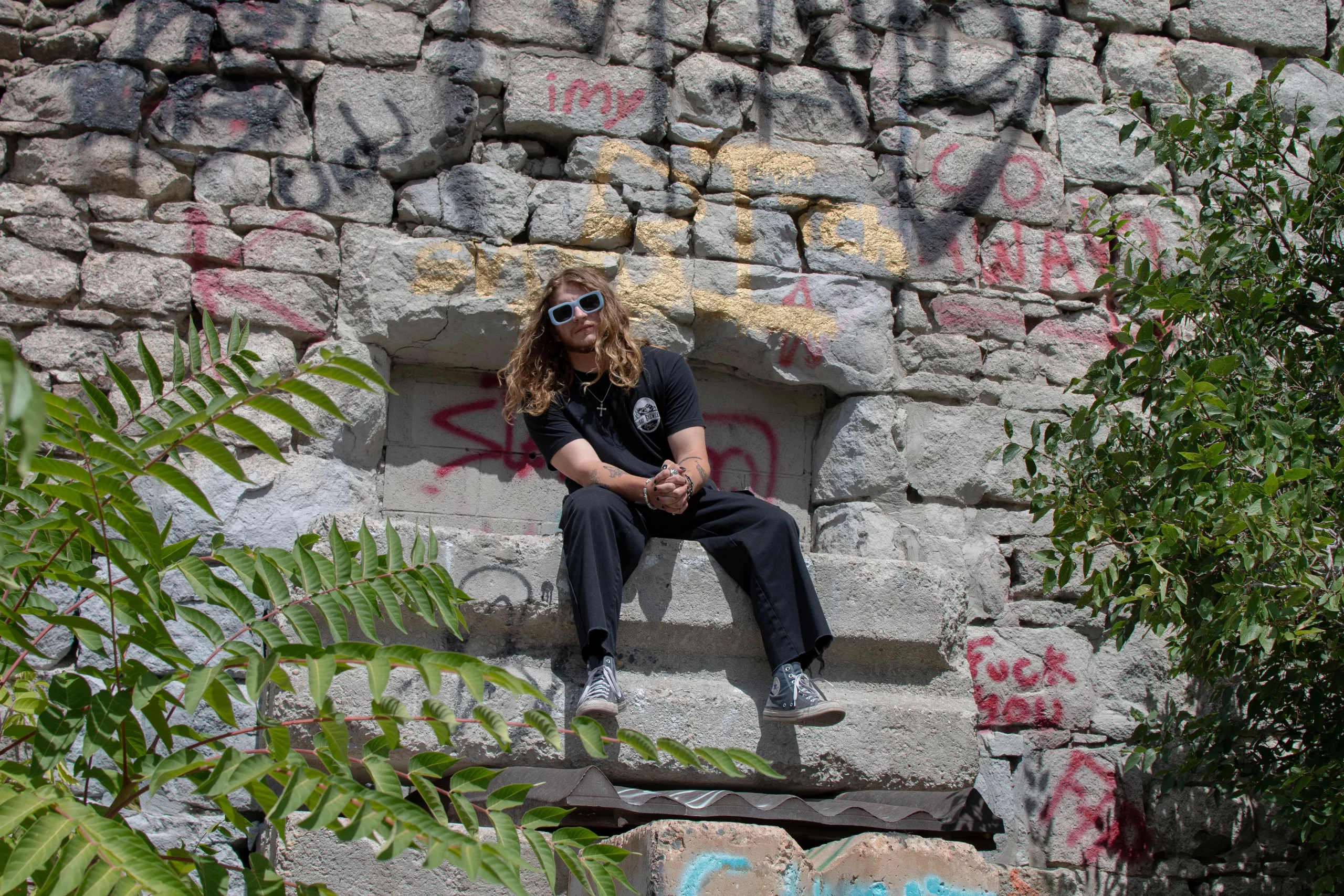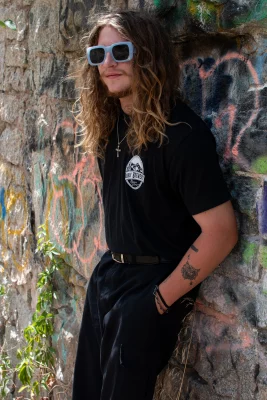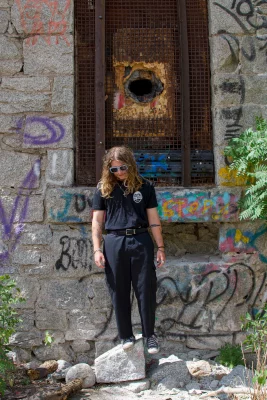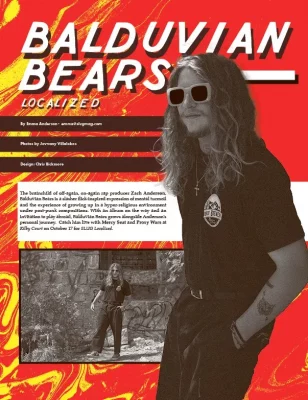
Localized: Balduvian Bears
Localized
Embrace spooky season with this synth-forward lineup for the ghouls and goths! Mercy Seat and Balduvian Bears co-headline this enchanting evening of darkwave, with Proxy Wars opening up the show at 8:00 p.m. Tickets are just $5 for this all-ages show at Kilby Court sponsored by Riso-Geist.
Self-identified “quasi-goth” Zach Anderson has been making a name for himself in Salt Lake City’s small, but mighty, post-punk and darkwave scene. As Balduvian Bears, Anderson uncovers and explores the previously repressed emotions that surround religious trauma through the lens of his unique fusion of musical inspirations and a bear mask-wearing alter ego that brings to mind Donnie Darko.

Anderson’s “extremely weird” religious upbringing led him to an intense passion for the “dark and spooky” side of things, a fondness that developed for him when he was in high school. His gothic inclinations led him not only to post-punk, but to horror films, especially those that are “violent and psychologically twisted,” which have served as great inspiration for Balduvian Bears. He hints that his admiration for slasher films will be utilized for an upcoming music video. Not all of his inspirations are so dark, though, as he cites the ‘80s Transformers cartoon series as another non-musical inspiration for his work.
Yes, the name is a Magic the Gathering reference—it’s ironically charming and lighthearted when considering what the bear character symbolizes in Anderson’s work. “Two years ago, I was in a psychosis for six months,” he says. “I was very suicidal. I didn’t do anything.” The bear came to represent that “culmination of [his] shadow and the darker side of [him].” This alter-ego, representing the side of himself that Anderson had previously been encouraged to repress, has been a much more effective approach to healing than just being told to pray about it, as he was in his youth.
“I feel like when I’m creating a sad boy beat, I’m not able to really put my emotions into it as much as I am able to channel [them] when I’m creating a post-punk instrumental.”
Anderson’s musical roots as a guitarist and hip-hop producer inform his current project, though he was once unsure about stepping out of his comfort zone and into the realm of post-punk he had begun to gravitate toward through artists like The Cure and Joy Division. He cites fellow Localized headliner Mercy Seat, Cassette Drift and Idle in Sport Mode as local inspirations in a similar genre. Previously a hip-hop artist, Anderson admits that the Balduvian Bears project is “where it all really came together.” The emotional expression that Balduvian Bears allows him, through music and visuals such as those in his music videos, seems to be what makes this current project extra impactful.
Beyond a surface-level enjoyment of the genre, Anderson was drawn to post-punk for how he believes it better allows him to express his emotions in

contrast to hip-hop. “I feel like when I’m creating a sad boy beat, I’m not able to really put my emotions into it as much as I am able to channel [them] when I’m creating a post-punk instrumental,” he says. He goes on to explain that he “feel[s] like a lot of the emotional nuance in ‘sad boy rap’ and similar genres is entirely lyrical,” while the instrumental arrangements of post-punk allow him to express his emotions in a more genuine way. Since minimal samples are used in the making of Balduvian Bears tracks, Anderson feels that he’s able to “really create that emotional soundscape from the ground up.”
“[I’m able to] really create that emotional soundscape from the ground up.”
Anderson says the second Balduvian Bears album is in the works, and while his personal, emotional experiences will still be at the forefront of the project, he’s excited to be writing from the experience of a now-sober person who’s no longer suicidal and is a brand-new father. “Happiness” and “gratitude” are words that come up—a far cry from the headspace he endured during the creation of his first album, which he describes as “the fucking throw up of all [his] dark depression” and an “existential crisis.” Anderson’s healing journey and optimism for the future of his music proves that, against stereotypes, artists do not, in fact, need to be “tortured” to create their best work.
Balduvian Bears’ new album is set to release this month, alongside a new music video. While he’s excited to play Localized on October 17 at Kilby Court with Mercy Seat and Proxy Wars, even bigger things are on the horizon for Anderson—including an invitation to play Wave Gotik Treffen, the world’s biggest goth festival, in Germany next year. Keep up with Balduvian Bears’ new music and upcoming shows on Instagram @balduvianbears.
 Graphic Designer: Chris Bickmore
Graphic Designer: Chris Bickmore
chrisbickmore.com | @bitterbuffalo1986
Walk us through how you created this layout. What inspired you when designing it?
For the Balduvian Bears layout, I wanted something that looked a little like a throwback. This was one where the pictures really determined the direction I wanted to go. I was really going for a ‘70s feeling, which has been something I keep going back to a lot this last year. Something about it makes me think of those Steve McQueen movies from the ‘70s like Bullitt.
Tell us about your design background. How has your style evolved over time?
I have an associate’s [degree] from SLCC in Graphic Communications and I’m currently at the University of Utah for my bachelor’s. I [will] have designed for SLUG for three years in December. My style has evolved in that I branch out a bit more from what I am comfortable with. I try to do new things often and learn new things. I think I used to really pigeonhole myself into more of a retro style (which I still do a lot) but I actively try to break out of being repetitive.
What are some of your design inspirations or influences?
A lot of mid-century design is a big inspiration for me. I love looking through old magazines and record covers from the ‘50s, ‘60s and ‘70s and get a lot of inspiration from those. I am also influenced by punk and hardcore design, incorporating a lot of that influence into things I do.
What does your graphic design process usually look like?
It sort of depends on the project. If it’s something with a quick turnaround, I might hop into Pinterest just to get some ideas of what direction I would like to go in. I also try to familiarize myself with whatever or whoever I am designing for. I usually do the monthly Localized layout for SLUG and I always try to listen to the band first, [then] check out their social media and any album covers of anything they have released. I want it to fit with their vibe and aesthetic as much as possible. Then I just go for it and see what happens initially, and refine it. If it’s something that I have more time I still do all of that, but I spend a lot of time just thinking about it while I am doing other things, and then I have more time to really figure out exactly what I am going for before I even open my laptop.
What is your favorite aspect of graphic design?
When people get excited about things I design. I like the feeling of people connecting to something that I made. I think that’s really the rewarding part of being a designer or an artist is when people get excited about something you made alone in your house.
Read more local music goodness:
Local Review: Painted Lines
Localized: AUXO
